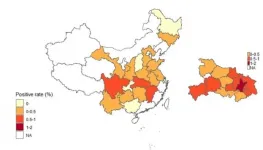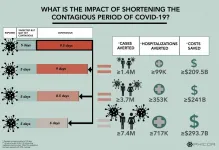(Press-News.org) The "Executive Order on Promoting American Seafood Competitiveness and Economic Growth," issued by the Trump administration in May 2020, lays out a plan to expand the U.S. seafood industry, especially aquaculture, and enhance American seafood competitiveness in the global market.
The goals of the directive are focused largely on growth and expansion of the industry, which includes wild-caught fisheries and farm-raised products, as well as recreation, processing and other industries that rely on fishing.
"The seafood industry in general is worth about $200 billion and accounts for 2 million jobs in the United States," said Halley E. Froehlich, a professor of fisheries and aquaculture at UC Santa Barbara, who with her colleagues finds that the executive order "ends up being a complicated and opaque ask," given the complexity of the seafood industry and the headwinds it has been experiencing of late.
"We started having some deep conversations about policy implications and what they meant relative to some massive disruptions," she said.
The seafood industry had already been fighting for stability in light of a two-year trade war with China -- the world's largest seafood consumer -- and by the time the executive order to expand was issued, U.S. seafood was in a historic freefall due to COVID-19. Meanwhile, slow pandemic relief funding and upcoming changes in the White House add another layer of uncertainty to the future of the seafood industry and its sustainable expansion.
However, it is possible to map out a sustainable means for growing the seafood industry, according to the researchers. Looking through the lens of the executive order, they outlined several guiding principles to bridge the current state of U.S. seafood and the desired outcomes of the federal directive.
Their recommendations are published in the journal Marine Policy.
Strategy and Data
Americans have a huge appetite for seafood. The U.S. is the world's largest net seafood importer, with a growing dependence on imports. According to the study, 85% of U.S. domestic wild-caught stocks are already fished at or near maximum sustainable levels.
Farmed seafood, on the other hand, makes up only about 8% of domestic seafood production and holds great potential. But it doesn't have the same level of coordinated monitoring and reporting as the much larger, wild fisheries sector. Questions remain about the type and location of these new farms -- where they won't interfere with wild fisheries or encounter opposition from the local community.
To address these and other complexities, the researchers call for "precise and strategic fisheries reforms" in response to the order's move to "reduce burdens on domestic fishing and to increase production."
"We wanted to articulate the things that could be done, and things that may actually be counterproductive," Froehlich said. For instance, removing regulations on a seafood sector that is already at its maximum sustainable capacity would likely not produce the effect sought by the order.
"We're pretty much at max for our wild fisheries," she said. According to the study there are smaller, more targeted measures that might increase profitability, though it is still unlikely that production would increase substantially.
Integrating wild fisheries and aquaculture sectors would also be beneficial, according to the researchers.
"The two systems are largely managed independent of each other," Froehlich said, "and this results in linkages that exist, but aren't necessarily accounted for." By employing an ecosystems approach, and collecting and releasing comprehensive aquaculture data, it would be possible to monitor the growth of aquaculture while reducing the potential of negatively impacting wild fisheries in domestic waters.
The growth of sustainable aquaculture and the future success of the U.S. seafood industry will also require some changes in perception, both local and global. As a means of food production, aquaculture is bound to have some sort of impact on the local environment and the local community, Froehlich said, making stakeholder input, transparency and access to information essential elements to address the resistance these seafood farms may encounter. For now, the U.S. largely displaces the production responsibility to other countries.
Meanwhile, the researchers have their eye on the incoming administration with the mounting bipartisan support for different kinds of aquaculture in the U.S. and possible changes to the protectionist stance the U.S. has taken on global trade. The seafood industry was cut deep when trade relations with China deteriorated, a struggle that only worsened with the COVID pandemic.
For U.S. fisheries and aquaculture, the researchers see a chance for the sector to not just recover, but build a better system that can withstand other shocks in the future, including climate change. "The pandemic has highlighted the weak points in the sector," Froehlich said, "so the chance to improve should not be overlooked."
INFORMATION:
Wuhan City in China was the first place to report COVID-19 in the world and--between December 2019 and May 2020--caused nearly two-thirds of all COVID-19 cases in China. Now, researchers reporting in PLOS Neglected Tropical Diseases have tested more than 60,000 healthy individuals in China for SARS-CoV-2 antibodies and concluded that thousands of Wuhan residents were infected with asymptomatic cases of COVID-19 after the infection was believed to be under control in China.
Rapid antibody tests are used to diagnosis present and past infections with the SARS-CoV-2 virus that causes COVID-19; positive IgG antibodies suggests a previous infection while IgM antibodies mean a current or recent ...
A new computational analysis suggests that a vaccine or medication that could shorten the infectious period of COVID-19 may potentially prevent millions of cases and save billions of dollars. The study was led by Bruce Lee along with colleagues in the Public Health Informatics, Computational, and Operations Research (PHICOR) team headquartered at the CUNY Graduate School of Public Health and Health Policy and the Lundquist Research Institute at Harbor-UCLA Medical Center, and publishes in the open-access journal PLOS Computational Biology.
While much of the ...
The fatal threat from diarrhoea and pneumonia to young children in the world's poorer countries can be drastically reduced by using traditional performing arts to encourage mothers to provide youngsters with safe food and water, a new study reveals.
The Gambia, like many other Low- and Middle-income Countries (LMICs) faces high rates of under-five deaths due to diarrhoea and pneumonia - the two highest causes of death in this age group in this country and globally.
Children transitioning from breastfeeding to eating food are at most risk, as complementary food becomes contaminated. Researchers working in The Gambia discovered that mothers' food safety and hygiene behaviours were massively improved by a low-cost behaviour change community ...
ANN ARBOR--A team of researchers has discovered an antibody that blocks the ability of the dengue virus to cause disease in mice. The findings open the potential for developing effective treatments and designing a vaccine for dengue and similar diseases.
Dengue virus, a member of a group of viruses called flaviviruses, causes 50 to 100 million cases of dengue disease each year, with no effective treatment or vaccine. Other members of this group include the viruses that cause Zika, yellow fever and West Nile fever.
In a new study scheduled to publish Jan. 8 in the journal Science, researchers from the University of California, Berkeley, and the University of Michigan revealed how an antibody called 2B7 neutralizes one specific protein made ...
Christina Krienke and colleagues have designed an mRNA vaccine that delayed the onset of and reduced the severity of multiple sclerosis-like disease in mice. The vaccine restores the body's tolerance to its own proteins, suppressing the characteristic immune overreactivity of the disease. The vaccine developed by Krienke et al. works in a targeted fashion to promote tolerance to specific disease-related proteins, an improvement over other approaches to treating the disease that induce systemic immune suppression that can leave an individual vulnerable to other ...
Policymakers around the world tend to reference new and highly cited COVID-19 research papers in their policy documents regarding the pandemic, Yian Yin and colleagues conclude after analyzing publications of both types from the first half of 2020. "Overall, this result shows that the coronavirus research used by policymakers aligns with what scientists heavily engage themselves," they write in a Policy Forum. Although government agencies produced more COVID-19 documents compared to think tanks and intergovernmental organizations such as the World Health Organization, Yin et al. found that governmental agencies are the least likely to cite science. Organizations like WHO are the most likely institutions to cite science, they write, suggesting that these organizations can act ...
Social contact can transfer the feeling of pain or fear in several animal species, including humans, but the exact neural mechanisms for this transmission are still being studied. Now, Monique Smith and colleagues demonstrate that the social transmission of pain and pain relief in mice is mediated by neural projections from the brain's anterior cingulate cortex (ACC) to the nucleus accumbens. The transfer of fear, however, is mediated by the ACC's projections into a different area of the brain called the basolateral amygdala. The findings help untangle the distinct neural circuits involved ...
Richard Tyser and colleagues have mapped the origins of the embryonic mouse heart at single-cell resolution, helping to define the cell types that make up the heart in the earliest days of development. Their techniques allowed them to identify for a first time a pool of progenitor cells that contributes to the formation of heart muscle cells as well as the early epicardium, the outermost layer of the heart. This layer provides cells and other proteins that guide the development and repair of heart tissue, so a better understanding of its origins could better inform regenerative heart therapies as well as improve ...
New treatments to cut the global death rate from dengue, Zika and West Nile viruses could result from research led by The University of Queensland.
Associate Professor Daniel Watterson from UQ's School of Chemistry and Molecular Biosciences said the team identified an antibody that improved survival rates in laboratory trials and reduced the presence of virus in the blood.
"We made a discovery in 2015 in the wake of the Zika outbreak that identified a new target for flavivirus treatments, a viral protein called NS1," Dr Watterson said.
"Now we've shown for the first time that a single NS1 antibody can be protective against multiple flaviviruses including dengue, Zika and West Nile.
"No other antibody reported has shown such a broad range of protection.
"The improved ...
One essential component of each eukaryotic cell is the cytoskeleton. Microtubules, tiny tubes consisting of a protein called tubulin, are part of this skeleton of cells. Cilia and flagella, which are antenna-like structures that protrude from most of the cells in our body, contain many microtubules. An example of flagell is the sperm tail, which is essential for male fertility and thus for sexual reproduction. The flagellum has to beat in a very precise and coordinated manner to allow progressive swimming of the sperm. Failure to do so can lead to male infertility. Researchers at the Institut Curie in Paris, the Max Planck Institute of Molecular Cell Biology ...


